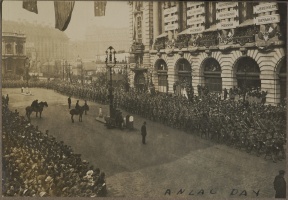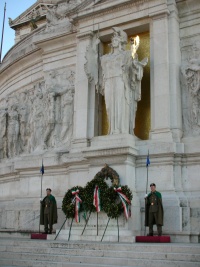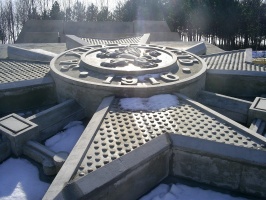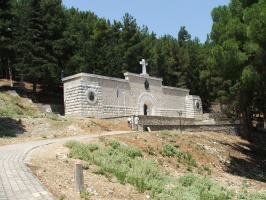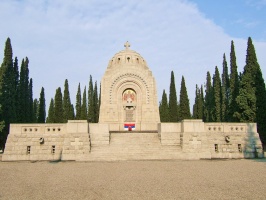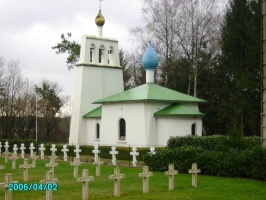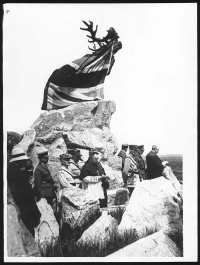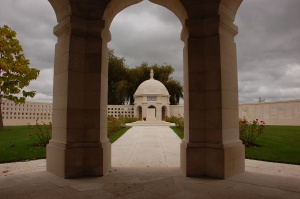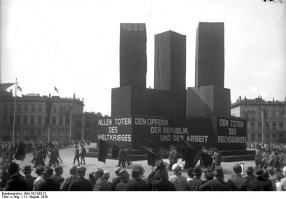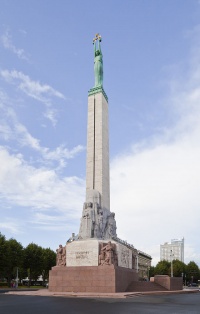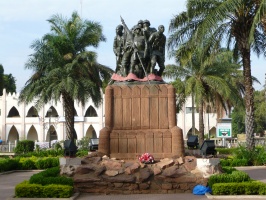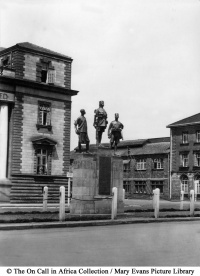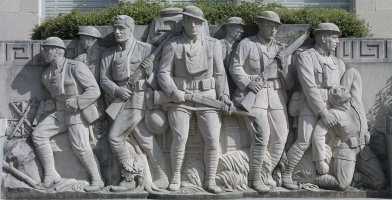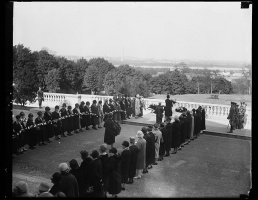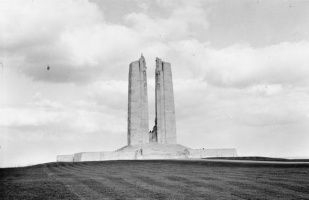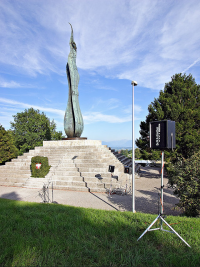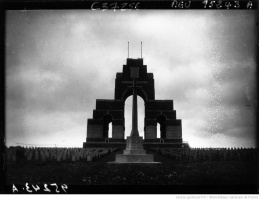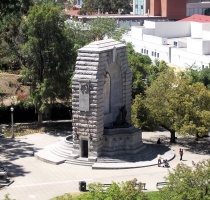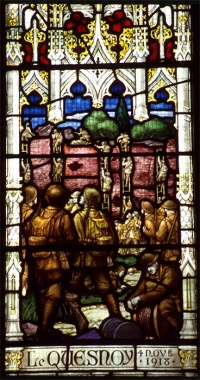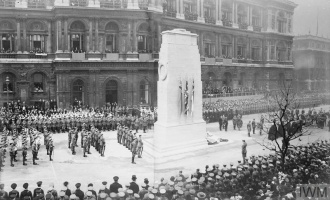Introduction↑
It is the considerable scale of human losses associated with a massive mobilization of manpower which explains the spread of the cult of the war dead across all societies involved in the conflict, on an unprecedented geographical scale. Never had a war brought about as many casualties and impacted so many loved ones. It would be illusory to engage in precise accounting. Out of 65 to 74 million mobilized people, the most rigorous studies provide a figure of some 9.5 million dead and missing combatants — including victims from captivity and disease.[1] The resulting mass mourning was expressed in a multitude of rituals, ranging from the most personal and intimate to the most official and public. Research on these rituals has been ongoing for some forty years now, rooted in a more social approach to the war, centred on experiences of combat and on veterans. Beginning in the 1970s, a plethora of studies on war monuments and ritual ceremonies was ushered in by the pioneering work and analyses of Antoine Prost and Reinhart Koselleck (1923-2005).[2] Since the 1990s cultural historians have also analysed expressions of grief, cultural representations of civilians, as well as commemorative forms illustrating the cult of the dead. Some authors, including George L. Mosse (1918-1999) and Reinhart Koselleck, analysed the construction of a cult founded on the exaltation of volunteering and the spirit of sacrifice and service to the nation over the longue durée.[3] Beyond the study of official commemorations, which has been thriving since the 1970s, historians have also undertaken to describe the shock wave that tore through societies at war. Thus, Jay Winter’s analysis of European societies has highlighted communities of mourning that brought tougher people linked and affected by a common death, while Annette Becker has interrogated modes of private and public grief at the intersection of patriotic engagement and religious faith. In an anthropological perspective, Stéphane Audoin-Rouzeau has defined concentric circles of grief around the war dead, which encompass individuals who were more or less directly affected by the soldier’s passing. Ken Inglis, meanwhile, has distinguished between those mourning the death of a son, a brother or a father, and “secondary mourners” grieving for a cousin, an uncle or a friend.[4] Literary expressions of mourning have also been the subject of important studies by Carine Trévisan, Jacqueline Manuel and Christina Spittel.[5] While, generally speaking, such studies have tended to be cast nationally, some works, admittedly few at this juncture, have considered the cult of the dead in comparative terms.[6]
Commemoration implies sharing grief resulting from the loss of someone dear. I am specifically concerned here with this collective dimension which subsumes individual grief. Indeed, mass death induced an invention of tradition, to borrow Eric Hobsbawm’s (1917-2012) expression: the creation by the state and by communities of grief of symbolic practices which normalized expressions of grief while simultaneously spreading cultural values and/or politics.[7] Did this “functionalization of grief” (R. Koselleck) ultimately allow a real expression of mourning in a consensual logic, by facilitating closure, or did it on the contrary elicit a political instrumentalization that in turn resulted in defuse, shattered and contradictory readings, thereby complicating the grieving process for survivors?
Unprecedented Mass Grief↑
Besides the massive scale of loss of life, the cult of the dead was founded on the specificity of grief over the course of the First World War. Indeed, mass death broke previous demographic trends, especially the receding mortality rates that had commenced in the 19th century, thanks to medical breakthroughs and public hygiene policies. The Spanish Flu added a new dimension to the hecatomb: angst-ridden imaginaries associated with pandemics, which 19th century cholera outbreaks had already stoked. Deaths in battle reversed the logical progression of generation succession, with parents burying their sons. In a number of states, at least 30 percent of men aged between 20 and 24 perished during the war (in Great Britain, Turkey and Serbia) and 60 percent of the group between 20 and 30.
Death was frequently framed and experienced as both distant and solitary. The course of battle often precluded any kind of immediate ritualization of the passage from life to death. The symbolic violence of this ritual absence was part and parcel of a more complex, durable, even interminable grieving process. Furthermore, many of the bodies of the deceased were never recovered, be it because they were pulverized by bombardments, or interred in a mass grave (a common practice at the start of the war). While traditionally funeral rites were supposed to contribute to consoling families, it often proved impossible to undertake burials in keeping with the usual rites. In Orthodox countries, such an absence of rites left many to believe that the soul of the deceased combatant would never find peace, which in turn elicited profound anxieties. However, such a sentiment extends well beyond regions of Orthodox faith. Hence the search for bodies, and the conception of specific rites to compensate for the absence of ceremonies. Among the many forms of mourning, those relating the missing or disappeared generated very specific forms of ritualization.
In some societies, the reality of a far-away death remained an issue beyond the end of the conflict, complicating any fulfilment of traditional rites. When a soldier fell in enemy territory, even if his gravesite was preserved, the possibility of visiting the site was compromised for loved ones. The cost of the trip alone was sometimes an impediment, with some states, like Germany, not covering such expenses. For many families from societies and states located beyond Europe, appropriating or re-appropriating the bodies of the fallen proved virtually impossible, with distance hindering the majority of those in question from travelling the thousands of kilometres necessary to pay their respects at the tomb of their loved ones. Many mourning processes thus remained “unresolved” in such instances, escaping any appropriation. Such was also the case for those mourning the missing in action for whom families sometimes possessed no tangible information concerning their last moments of life. For many families, the years and decades that followed were marked by the quest for so much as a trace of the missing. In Australia and New Zealand, the quest assumed a particular form: families kept or recuperated scattered objects associated with the missing, many years following the passing. These became veritable relics of the loved one, and could include items of clothing, personal objects, or a bible.[8] Private mementos were sometimes crafted, in the form of medallions and diplomas. Around the hearth, families piously preserved photos of the grave, taken by a comrade or a family member.
In order symbolically to fill the distance between the grave sites in Europe and the societies beyond that continent, symbolic bridges were sometimes erected. Thus, the memorial gardens of Adelaide drew inspiration from the Imperial War Graves Commission, duplicating most notably its rows of Bloomfield Crosses of Sacrifice. Inscribed on the memorial are the names of the deceased, as well as those of the survivors.[9] Thus, a duplication of homages occurred, as in the case of Saint Andrews church in Cambridge, New Zealand, whose stain glass reproduced a commemorative painting showing the liberation of the town of Quesnoy in Northern France, on November 4, 1918. The stain glass windows were unveiled in 1923, the very day of the inauguration of the memorial in France.
A New Funerary Dimension of the Battleground↑
Subsequently, in the 1920s and 1930s, some mourners or their descendants found their way to the former front lines, in order to grieve their dead, in one of the countless military cemeteries or on one the memorial grounds of the war. Indeed, some of the scars of battle were entrenched and extended: some battlegrounds were preserved, while many monuments were erected, some of them becoming the site of ceremonies organized by veterans’ organizations or by the state. The cult of a citizen sacrificing their life for the defence of their nation began spreading at a concomitant pace with the spread of democracy in the 19th and 20th centuries.[10] Its antecedents can be identified in the war of 1812 in Canada, in the US Civil War, in the lands that would become Germany in the 1860s and 70s, and in the Russo-Japanese war for both belligerent sides. The memorial recognition of individual soldiers was then based on patriotism, and, depending on the political regime, on dynastic or civic duty. By generalizing the funerary and commemorative practices that that had been budding since the 19th century, the battlefield became a specific site of the cult of the dead. The public was reminded of the reasons for the sacrifice by the erection of funerary monuments and by maintaining and tending to combatants’ gravesites.
In the case of the First World War, the first monuments were erected as early as 1915 and 1916, in particular on the 1914 battle sites and in makeshift cemeteries. Thus, the Germans erected sizeable commemorative structures at Saint-Quentin (Aisne department), which were inaugurated in October by Wilhelm II, German Emperor (1859-1941).[11] Similarly, other early monuments of this sort were erected at Sedan (Ardennes department) on the Western Front, but also in the Balkans near Belgrade, in this case on the initiative of August von Mackensen (1849-1945). In Tsarist Russia, comparable projects were contemplated in 1916.
Postwar, imposing monuments were constructed along the main hubs of the great offenses. The accompanying ceremonies were grand in scale, and involved leading heads of state and military figures from the war. On the Western Front, each state from the victorious side sought to underscore their nation’s engagement as well as the sacrifice of their soldiers on the front line. On July 31, 1920, the French government thus wrote into law a plan to erect national monuments that would be erected over the coming decades, most of them associated with massive military necropolises: Notre-Dame de Lorette, Douamont, Hartmannswillerkopf, Mondement, Cerny-en-Laonnois. In much the same vein, the United States ordered the construction of major monuments at Château-Thierrey (Bois Belleau), Saint-Mihiel, Montsec. As for the Canadian government, it opted to sanctify the devastated landscape of a former battlefield. Vimy ridge in Artois was thus converted into memorial parks that kept the scars of battle intact. Newfoundland, which was an autonomous part of the British Empire at the time, made a similar choice in Beaumont-Hamel.
As for the British government, it had many edifices erected which paid tribute in particular to the dead of the British Empire. Among them one should include Menin Gate in Flanders and Thiepval in the Somme, both of which feature triumphal arcs engraved with the names of thousands of deceased.[12] Such memorials to the deceased were constructed by the Imperial War Grave Commission as far as the desert in Bassorah, Iraq, commemorating the 40,500 soldiers of the British Empire who fell between 1914 and 1921 in operations in Mesopotamia.
On the Italian Front, gigantic necropolises assembled soldiers’ bodies, integrating as few enemy dead as possible. Several imposing constructions from this era still dot the former front line: sacrario militare di Asiago, sacrario militare del Monte Grappa, Bolzano’s victory monument for the mountainous part of the front, sacrario militare di Oslavia, sacrario militare di Redipuglia, one of the world’s largest cemeteries, in Gorizia province, commemorating the battles of Isonzo.[13]
On the Eastern Front, commemorative buildings were not always the fruit of public initiatives. Consider the large-scale German commemorative ensemble of Tannenberg, a grandiose fortress erected thanks to private collections between 1924 and 1927 in East Prussia. In Latvia and Lithuania, such large edifices were rarer: the memory of the dead was kept alive in small cemeteries such as the Brother’s Cemetery (Brāļu Kapi) in Riga, which was completed between 1924 and 1936.
The many memorials in the Balkans include the one dedicated to the Serbian army on the isle of Vido, the Entente monument to the Eastern Front at Latomi, and the British one on Lake Doiran (Greece). In Romania, several mausoleums were erected, most of them the result of local initiatives. They feature remains in an ossuary, as at Marasesti, Marasti, and Sojeva, for instance. On the Gallipoli peninsula, each of the former belligerent sides erected colossal edifices, a significant departure from other fronts where often only the allies constructed imposing structures. The ANZAC Lone Pine Monument, together with the Çanakkale Turkish memorial, provide reminders of the casualties in the Dardanelles.[14]
These monuments at once reflected martial feats and were most often associated with military cemeteries. Even if one allows for cultural particularities, their presence on all former battlefields points to a homogenization of behaviours for honouring the war dead. The existence of these countless military cemeteries, of monuments on which the names of the dead were inscribed, constitutes a characteristic of the cult of the fallen of the Great War. 1914-1918 marked for many societies an anthropological and cultural rupture, inasmuch as the burial in an individual grave became the norm beginning in 1915, especially on the Western Front. During the war, the fighters themselves erected makeshift monuments or funerary decors on the tombs of their comrades with more or less durable materials (ranging from wood to concrete or granite). A few traces of this phenomenon remain today on some temporary British war cemeteries which were ultimately made permanent (such as Louvencourt in the Somme), or on sites that were kept in state (le Donon in the Vosges).
The high command was compelled to completely transform the way in which bodies were handled, for reasons of public hygiene to be sure, but mostly due to pressure from grieving families who demanded the return of their loved ones beginning in the fall of 1914.[15] This particular request was rejected and put off until the end of the war. Conversely, the practices of identifying the deceased and burying them in individual graves became widespread. However, not all states were able to bring about the practice of retuning bodies to families in the wake of the war. This right of return was inscribed in the politics of the settlement of the conflict in France, Belgium and the United States.[16] The issue gave rise to a violent debate in Britain, France and the USA.[17] While the Americans brought it about, the British renounced in the end in order to instead impose an egalitarian treatment for all the fallen.[18] However, the British decided to maintain provisional military cemeteries from the war, while in other nations including France, which had allowed the restitution of bodies, the dead from temporary cemeteries were exhumed and reinterred in gargantuan necropoli. As for the German war dead, until 1924 the handling of enemy bodies on the Western Front was only guaranteed in the most minimal of terms by virtue of articles 225 and 226 of the Treaty of Versailles, which essentially enjoined all parties to respect the war dead. Nevertheless, resentment towards the former enemy remained powerful, and in some cases, the French reinterred individually buried German soldiers into mass graves, precisely as the French were relocating their own war dead to necropoli. A private German association (Volksbund Deutsche Kriegsgräberfürsorge) was only able to enter these necropolis in the middle of the 1920s. This nationalist organization operated outside of the scope of the republican government which had given it free reign to tend to German war graves. Individual graves, which were the preference of most families, were not the VDK’s modus operandi: it grouped several bodies under a single cross or under a tree.
Vanquished nations proved unable to undertake elaborate ceremonies or to erect vast memorial ensembles atop former battlefields. Thus major German war memorials from wartime experienced varied fates: that of Saint-Quentin has been preserved, whereas that of Sedan underwent more war damage. In Belgium, in the wake of battle, several German monuments constructed during the war within the confines of Belgian cemeteries were destroyed (this occurred at Antwerp, Bruges and Liège).
Burial and preservation policies allowed some families, as well as comrades of the deceased, to undertake a pilgrimage on the site of their loved ones. This was the case of the French state, which funded a trip per year to a military gravesite for close relatives. Other such pilgrimages were organized by faraway nations, something that required considerable logistical and funding efforts, be they private or public in nature. Thus in 1928, the British Legion allowed tens of thousands of Britons to follow the Prince of Wales, later Edward, Duke of Windsor (1894-1972), to Ypres. That same year, a hundred or so Australians voyaged to the Lone Pine Memory Cemetery, then on to the ANZAC sites in France and Belgium.[19] In the United States, the federal government supported pilgrimages organized in 1930 and 1933 by the American Gold Star Mothers, with a goal of folding into the national fabric immigrants of German ancestry, thereby ascribing value to their particular sacrifice to the nation. These trips were subject to the rules of American racial segregation.[20] As for the German case, without help from the state, such pilgrimages, which increased starting in the late 1920s, were more often the result of private undertakings. They would eventually become more formalized in the 1960s, in a new era, fostered by the spirit of Franco-German reconciliation. All of this said, such pilgrimages were not within reach of all. Under the circumstances, it was most often far from the front, in their site of residence, that mourners expressed their sorrow.
Mourning and Public Recognition: Memorializing the Fallen↑
Over the course of ceremonies, grieving was expressed via complex processes of memorialization. Through these events, families were sometimes able to obtain public recognition of their sorrow. At the core of these ceremonies, monuments proved essential, irrespective of their precise form. They most often featured an inscribed list of the dead. The latter tended to individualize the fate of each person in this mass war, and restored a symbolic presence as a response to the immensity of loss. Monuments also provided a political dimension to survivors’ grief, most often by lending a patriotic and nationalist meaning to war losses, by way of decorative elements or of the inscriptions themselves.
On a regional or local scale, the cult of the war dead from 1914-1918 was sometimes grafted onto that of previous conflicts. Thus, in France, some municipalities chiselled the names of casualties from the Great War onto monuments to the war of 1870-1871, especially in regions that had been particularly affected by the Franco-Prussian war, as in the Loiret department. In Serbia and Greece, some monuments linked the dead from the Balkan wars and those of the Great War, in a sweeping chronology that ran from 1912 to 1919. This was not the case in Romania, however, where the dates on monument inscriptions commence in 1916 and extend up to 1920, including in this instance battles against the Hungarian communist republic.
Commemoration ceremonies did not begin at the end of the war, but rather at its inception. After the first funeral services organized for soldiers felled at the war’s very beginning, a wave of sizeable ceremonies began in the fall of 1914 around all-saints day in Catholic countries. In a bid to maintain the war effort, these blended a civic cult and the mobilization of spirits, as well as religious rites. The generalization of tributes came with the end of the war. Ritual forms were set in the 1920s, covering a considerable diversity in modes of expression.
In a first phase, these ceremonies were arranged by the clergy, by reserve officers in service, or by veterans of past wars (as in France, where they transmitted rituals from the 19th century). However, a second phase ensued in 1916, during which demobilized soldiers, and in particular the wounded who formed into associations, took over the organizing of these events. In most countries, federations were formed out of numerous veterans’ groups (including the Great War Veterans Association in Canada, the Union Fédérale in France, the Society of Reserve officers and combatants in Yugoslavia -- Udruženje Rezervnih oficira i ratnika -- the American Legion, and so on). These played a crucial role, as lobby groups exerting pressure on politicians and on official institutions, in defining and maintaining a commemorative period, a moment of silence to all the dead, marking the nation’s recognition towards its defenders. These rites constituted one of the few examples of a “civil religion,” featuring corteges of veterans and representatives of the nation’s civil, military and religious institutions. Together, they paid their respects at war memorials, deposited wreaths and flags, gave speeches dedicated to civic and moral values – all of these elements converged in postwar commemoration.
Among nations on the winning side in 1918, the armistice emerged as a specific celebratory day: November 4 in Italy, November 11 in Great Britain, Canada, Austria, the United States and France. This day of remembering was first honoured in 1919 and 1921, depending on the case, and in some instances, became a state holiday (this occurred in France in 1922). Other nations selected alternate dates: after some hesitation and debate, up to 1922 Belgium decided to mark August 4, date of the refusal of the German ultimatum in 1914. However, post 1922, it joined the ranks of nations that observed November 11.[21] Elsewhere, major commemorative days co-existed on the calendar. In New Zealand and Australia, April 25, ANZAC day commemorating the landing in the Dardanelles (a day of respect that was already honoured during the war), tended to dwarf Armistice Day, although the latter remained commemorated. The Returned and Services’ Association or RSA sought to organize ANZAC day in a homogenous way across New Zealand, with the idea of honouring the dead in an explicitly funerary manner. ANZAC day also assumed a ritual dimension for the mourners. In the United States, meanwhile, Memorial Day, which in 1868 had been dedicated to the dead of the Civil War, and in 1882 had become a day to mark the dead of all wars, was observed during and after World War I. However, the American Legion lobbied for the creation of an Armistice Day, a day that would mark victory as well as the experience of those having fought in Europe.[22] President Woodrow Wilson (1856-1924) did indeed create this national holiday in 1919 with the goal of honouring those who died to bring about peace. It became a statutory holiday in 1938 for federal employees.
In Germany, veterans’ organizations proved to be far more divided and remained politically quite distinct. Thus, the Stahlhelm, created in December 1918, dispensed a very nationalist and anti-republican ideology. It was also sizeable, bringing together some 350,000 members in 1932. Conversely, the Reichsbanner Schwarz-rot-gold, founded in 1924, which counted some 1.5 million members, was situated more to the left. Among them one finds many workers who stood up for the Weimar Republic. The two rival associations divvied up commemorative time and space, for the they paraded at different moments, while displaying opposing symbols and discourses. Sometimes clashes occurred, as was the case when commemorations of the Great War became entangled with the funeral of President Friedrich Ebert (1871-1925) in March 1925.[23] Unsurprisingly, under the circumstances, the organizations failed to agree on a single commemorative day. Catholics hoped that the day would coincide with All-Saints Day, while Protestants proposed a late November Totensonntag Communists preferred August 3, date of the German entry into war, while nationalists chose June 28 to remember the signature of the Treaty of Versailles. Other nationalists preferred the end of winter, so as to tie the commemoration with the nation’s symbolic regeneration. In 1932, Totensonntag won out, but no longer because of it was defended by the Protestant Church. Once in power, the Nazis would choose the return of spring to celebrate the day of heroes or Heldengedenktag.
In areas that were constituting nation states, commemorations of the Great War provided an opportunity to project an idealized nation, unified, equal, open and detached from personal interests (consider the case of Canada). They maintained the idea of sacred union, a notion that would quickly be put to the test by tensions stemming from a complicated demobilization process and by the impossibility of returning to a pre-war normal.
In some cases, ceremonies did not so much foster the creation of a specific time, but were instead inscribed into traditional religious calendars. Thus, in Romania, the Day of Heroes appeared in 1920 and coincided with the Orthodox celebration of Ascension. Other dates were selected in territories acquired over the course of the war. In Transylvania, for instance, the local Romanian population selected December 1, for it reminded them of their annexation by Romania. Conversely, Hungarian or German-speaking populations tended to prefer November 11. In Yugoslavia, and particularly in Serbia, interwar commemorations were linked to pre-war festivities. Thus, prior to the Great War, June 28 was a religious celebration, Saint Vitus day. The date was also close to the anniversary of the battle of Kosovo in 1389, which symbolized the birth of the Serbian nation. Gradually, June 28 emerged as the day of national commemoration, still associated with the battle of Kosovo but also integrating the memory of the dead from the wars running from 1912 to 1918. The date also conjured up, to some degree, memories of the assassination in Sarajevo and the signature of the Treaty of Versailles, which brought about the creation of the Kingdom of Serbs, Croats and Slovenes. In these sates which had suffered considerable loss of civilian life, the public commemoration of the dead could not be undertaken in a unified manner.
This cult of the war dead was also articulated for the first time around a novel figure, that of the unknown soldier, whose interment points to the specificity of combat in World War I. This new homage was paid to a soldier rendered anonymous by the type of combat brought about by industrialized warfare. Yet the unknown soldier represented more than this; he was also an ordinary citizen who had died to defend the nation.[24] This new ritual took shape in an already sacralised space whose symbolic role grew more significant still, investing it with meanings that last to this day. Thus, the British unknown soldier was buried in 1920 in Westminster Abbey, followed by the French unknown soldier who was entombed on November 11 of that same year under the Arc of Triumph in Paris. Bodies from eight parts of the front lay in state in Verdun’s citadel. There, a young soldier selected one of the eight coffins, which was solemnly brought to Paris. In the United States, the unknown soldier constituted the only initiative in this realm that drew unanimity in a society that was otherwise divided over the choice of memorial, be it a cenotaph, a monument, or some kind of dedicated building such as a hospital, library or town hall. Selected on Memorial Day, May 30, 1921, the unknown soldier was then transported via the USS Olympia, then lay in state in the Capitol, before being buried at Arlington cemetery. In Belgium, an unknown Jass was put to rest in 1922. This initiative was supported by the public and brought forward by parliamentarians. The government opposed it at first. It did not want some “forgery of what had been done in France and England,” preferring instead to forge ahead with a monument to the memory of all the heroes of the Great War that was planned by the law of July 14, 1919. The two projects were eventually merged.[25] Romania, too, adopted this ritual in 1923, following an identical ceremony to the one that had taken place in France. Later still, between 1934 and 1938, a tomb to the unknown soldier was erected in Yugoslavia. Aleksandar I, King of Yugoslavia (1888-1934) funded it personally, thus displaying his desire to build a unified Yugoslav nation, thereby attempting to undercut the perception that the new state favoured Serbs. Over the course of the 1930s, many other European states laid an unknown soldier to rest in a sacralised site (Austria, Bulgaria, Greece, Hungary, Poland, Romania). As for Germany, after considerable delay, in 1931 the guard post at the Neue Wache, which had first served as the headquarters of the Prussian royal guard, then the imperial guard up to 1918, finally emerged as a national site dedicated to all war victims. However, Germany never buried an unknown soldier there. Nevertheless, in the memorial fortress of Tannenberg, tombs of twenty unknown soldiers were arranged around a central cross. However, in 1934, Field Marshal Paul von Hindenburg’s (1837-1934) grave was dug at the site, and concomitantly, the remains of the twenty unknown soldiers were shifted to lateral chapels. Thereafter, the Nazis presented Hindenburg’s tomb as a symbolic site folding together of the representation of the general with that of ordinary soldiers. Adolf Hitler (1889-1945), the anonymous corporal of World War I, thereby channelled to his own benefit the figure of the unknown soldier.[26]
Commemoration and Consolation↑
It is difficult to ascertain whether the memorialization of the dead, erected in both funerary and monumental forms as an inscription of sorrow in official time, along with the policy of commemorative ceremonies, really enabled any closure for those grieving. At the time, the psychological workings of mourning remained hazy. To contemporaries outside of Sigmund Freud (1856-1939), whose work was not yet widely available, the different phases of grieving were not yet identified. Since grief resolution is a fundamentally intimate process, only exceptionally well documented histories have been able to tangibly grapple with it. Individuals handled it variously. Katherine Mansfield (1888-1923), a New Zealand writer, surrounded herself with images of her brother; Käthe Kollwitz (1867-1945), a German artist, made it the inspiration for her sculptures, much like the French master glass worker Albert Echivard (1866-1939). Others, such as the Australian politician Henry Bournes Higgins (1851-1929), undertook pacifist campaigns. Meanwhile French sociologist Emile Durkheim (1858-1917) walled himself in silence. British pacifist and feminist Vera Brittain (1893-1970), for her part, cultivated her obsessions over the details of her loved ones’ demise at war.[27] Some found solace in religion, while others in English-speaking countries especially, attempted to contact the dead: the occult, and spiritism in particular, constituted paths taken by many mourners.
Mourners also communed in ceremonies of various scales, bringing together members of a profession, a parish, a school, a former regiment, a town, etc. These communities of grief gave structural form to public expressions of survivors’ grief. Each individual could no doubt find therein the practices and words allowing them to advance in their own grieving process. Such rites were gendered, insofar as men were typically the only ones to pronounce speeches, regardless of their precise rank or function.[28] Nevertheless, women played essential roles in the cult of the dead, most notably in grave upkeep — be it in military cemeteries or individual tombs — and in the transmission of the memory of the departed within family units.
Rituals featured a specific phase that gave rise to emotion and to personal expressions of suffering. Thus, the minute of silence introduced in Great Britain as of 1919 was soon found in other societies, as well as the reading out of the names of the dead, a secularized ritual originating in Catholic liturgy. These readings of names were typically part of a quest for meaning, both religious and political. Depending on the case, the departed had died for the motherland or fatherland, to end all wars, or for their religion, and their sacrifice was most often framed as an essential expression of the duty to defend one’s country. For the victors, this was a just war, in which the combatant served as a Christian soldier (in France and in Canada for example), or an exemplary citizen who preserved the values of liberal regimes. The sacrifice of the soldier defending their national land, or forging a nation through their sacrifice became a sort of quintessential expression of citizenship, achieved in the trenches and inspiring generations to come. In solemn speeches pronounced over the course of ceremonies, the violence of death was most often euphemized, as it was as well in commemorative statuary.[29] Death was transfigured by heroism, in keeping with the cultural mobilization that had occurred in wartime. Then death had most often been presented as instantaneous, eliding suffering. Depending on the orator, the memory of the deceased could be associated either with Christian paradise or to secularized eternity in the framework of national memory. This hero-making dimension dampened over the course of the 1920s in some countries (such as France) but remained fundamental in Germany and in Austria. There, the experience of war remained mystified, thereby maintaining the presence of a war culture that continued to operate unabated in countries where defeat was repressed. In fascist Italy, meanwhile, the state instrumentalized the elevation of the sacrifice of the caduti so as to transcend social disparities and cement the Italian nation.
Heroism featuring an armed citizen, sacrificing their life, also constituted an important reference in countries that dispatched volunteers to the war (Australia, New Zealand), and were being forged as young nations (Australia, Canada). In such countries, volunteering was associated with an independence of spirit, an individualism which founded democratic egalitarianism and helped explain the resilience of men in combat. In New Zealand, while Anzac Day remained heavily observed between the wars, imagery of this sort did not develop in the same manner and remained centred on an homage paid to the dead more than on an exaltation of national identity. Here, the central motivational value was that of loyalty to the empire – a loyalty re-enacted as of 1916 in small towns in ceremonies that proved to be very popular.[30]
Such hero-forging or patriotic discourses seem to have been the preserve of the elites, and historians have constantly probed their reception by the rest of the population. Near the end of the 1920s, commemorations often took on a more pacifist bent, especially in France, Great-Britain and Canada. As the Second World War approached, against a backdrop of rising international tensions, commemorations of the Great War frequently became mobilizing and even propitiatory in nature. The “never again” or “Nie wieder” spirit that had developed in Germany in the 1920s, and in France and Britain mostly over the course of the following decade, brought with it serious critiques directed at certain monuments now deemed too nationalistic. In France, as rural veterans appropriated ceremonial forms and took the stage to speak with greater frequency in the 1920s, pacifism founded on a logic of international arbitration was reinforced, without however completely overturning patriotic values.[31] This said, socialist movements rejected patriotic readings of sacrifice, as did Christian ones, including those opposed to conscription in Australia. In the United States as well, critics proved virulent. Thus, the American Legion presented the tomb of the unknown soldier as a symbol of sacrifice, yet it was also considered in more ironic terms by others, with the unknown soldier becoming in a sense the prisoner of a nationalist commemoration. In New Zealand, starting in 1922, commemorations became a duty towards the dead rather than an exaltation of victory. In defeated powers, ritualization of grief did not lead to unified expressions. Nationalist meanings and readings maintained a strong presence in Germany: they were institutionalized after Hitler’s coming to power in 1933.
The Elided Dead↑
The cult of the dead proved less enduring in two other contexts: in Bolshevik Russia and in colonial societies. In the former, Soviet society long denied those lost in a war defined as capitalist in nature. The dead of a war that had been declared by the Czar and which ended in civil stife were thus effaced for nearly the entire 20th century. Necessarily private, even hidden, symbolic strategies utilized by Russians remain a topic to be explored by historians, although some ink has been spilled on Russian emigres who fled the revolution and the civil war, and developed their own commemorative rituals. In France and in Czechoslovakia, these emigres had memorials erected to the Russian dead of the Great War. These undertakings were conducted in a spirit of sharing with former allies, and in a logic of micro-communities.
As for colonial societies, western rites observed by the colonizers often had little bearing on the colonized. In some African societies, colonial rites around dead soldiers were seen by some as facilitating the passage of the deceased from an impure site to a purer realm. In cases where bodies were buried far away, some African rites could not be observed. In the absence of archival records or of oral testimony on the matter, such rites remain relatively undocumented. It is the rituals undertaken by the colonizers that generated the most traces in the archives and hence studies by historians.[32] What is certain is that colonizers utilized and spread the same commemorative practices overseas as they did at home. Thus, the two minutes of silence were observed on November 11 in British barracks in India, but no commemorative space was dedicated to the dead from that territory. Monuments were erected in the main cities of French West Africa, for instance at Bamako, Dakar, and Saint-Louis in Senegal. These monuments served as propaganda tools and reinforced colonial hierarchies. Indeed, despite the fact that the courage and heroism of African troops was evoked during speeches and ceremonies, the monuments still depicted white officers lording over colonial troops. In colonial contexts, the list of the war dead was only very rarely inscribed, and the reading out of names equally infrequent over the course of ceremonies designed more to underscore the presence of the colonizers than to recognize the sacrifice of the colonized. At Dar es Salam, Nairobi and Mombasa, workers who died during the war were honoured by separate memorials, featuring no individual names. Conversely, monuments erected in Rhodesia, Nyasaland and Malawi in the 1920s seem to have followed the inspiration of the Imperial War Graves’ Commission. The latter tended to emphasise an egalitarian treatment of the war dead, with a systematic inscription, whenever possible, of the names of the deceased. This was not the case everywhere in Africa, despite the pressure of local populations. As a rule, these monuments to the Great War in Africa have been preserved and respected.
Conclusion↑
The cult of the dead of the First World War was thus conditioned first and foremost by national readings. Even attempts at common commemorations, bringing together former adversaries, such as the ceremony to mark the twentieth anniversary of the Battle of Verdun in 1936, failed to break this mold. Pacifist monuments remained the exception, although it is worth mentioning those of Saint-Martin d’Estreaux in France and Anweiler in Germany. Between the wars, rare were those that assumed any sort of international dimension. One exception can be found in Liège, Belgium. There, starting in 1928 an inter-allied memorial was begun on Cointe Hill, funded by public and private subscriptions and by entente nations. It was inaugurated in 1937. The monument at Čačak in Serbia constitutes a rare, indeed unique example of an ensemble that looked beyond national and alliance frameworks. Erected in 1934 by a branch of the Inter-allied Veterans’ Federation this ossuary/monument constituted a religiously ecumenical memorial, dedicated to belligerents of all sides and of all faiths, be they Catholic, Orthodox, Jewish or Muslim. Only in the 1960s did common commemorations occur for the dead on all sides—a trend that would accelerate towards the close of the 20th century. On November 11, 2014, a monument was unveiled to all the dead without regard for rank or nationality: the ring of memory at Notre-Dame-de-Lorette in France. Despite these shifts, one can also observe a continuity in the cult of the dead which speaks in itself to the lasting imprint of the mass grief of 1914-1918 over the culture of all the societies involved in the conflict.
Stéphane Tison, Le Mans Université
Section Editor: Elise Julien
Notes
- ↑ Winter, Jay: Demography, in: Horne, John (ed.): A Companion to World War I, Chichester 2010, p. 249; Janda, Lance: Combatant and Non Combatant, in: Tucker, Spencer C. (ed.): The Encyclopedia of World War I. A Political, Social, and Military History, Santa Barbara 2005, vol. I, p. 273.
- ↑ Prost, Antoine: Les anciens combattants dans la société française, vol. 3. Mentalités et idéologies, Paris 1977; Koselleck, Reinhart: Kriegsdenkmale als Identitätssiftungen der Überlebenden, in: Marquart, Odo / Stierle, Karl-Heinz, (eds.): Identität. Munich 1979.
- ↑ Mosse, George L.: Fallen Soldiers. Reshaping the Memory of the World Wars, Oxford 1990; Koselleck, Reinhart / Jeismann, Michael: Der politische Totenkult. Kriegerdenkmäler in der Moderne, Munich 1994.
- ↑ Inglis, Ken: Sacred Places. War Memorials in the Australian Landscape, Melbourne 1998; Winter, Jay: Sites of memory, Sites of mourning. The Great War in European cultural history, Cambridge 1995; Becker, Annette: La Guerre et la foi, de la mort à la mémoire, 1914-1930, Paris 1994; Audoin-Rouzeau, Stéphane: Cinq deuils de guerre, Paris 2001.
- ↑ Trévisan, Carine: Les fables du deuil. La Grande Guerre. mort et écriture, Paris 2001; Manuel, Jacqueline: We are the women who mourn our dead. Australian civilian women’s poetic responses to the First World War, in: Journal of the Australian War Memorial 29/11 (1996); Spittel, Christina: Remembering the War. Australian novelists in the interwar years, in: Australian Literary Studies 23/2 (2007), pp. 121-139.
- ↑ Mosse, Fallen Soldiers 1990; Winter, Sites of memory, Sites of mourning 1995. Also see Julien, Élise: Paris, Berlin. la mémoire de la guerre, 1914-1933, Rennes 2010; Ziino Bart (ed.): Remembering the First World War. London et al. 2015.
- ↑ Hobsbawm, Eric / Ranger, Terence: The Invention of Tradition. Cambridge 1983, p. 1-14
- ↑ Ziino, Bart: A distant grief. Australians, War Graves and the Great War. Nedlands 2007, p. 22.
- ↑ Scates, Bruce: Return to Gallipoli. Wallking the Battlefields of the Great War, Cambridge 2006, pp. 29-34.
- ↑ Hagemann, Karen: German heroes. The Cult of Death for the Fatherland in nineteenth-century Germany, in: Dudink, Stefan / Hagemann, Karen / Tosh, John (eds.), Masculinities in Politics and War: Gendering modern history, Manchester 2004, pp. 116–34
- ↑ Hardier, Thierry / Jagielsky, Jean-François: Combattre et mourir pendant la Grande Guerre (1914-1925), Paris 2001, p. 273.
- ↑ Stamp, Gavin: The Memorial of the Missing of the Somme, London 2006; Dendooven, Dominiek: Menin Gate and Last Post. Ypres as Holy Ground, Brugges 2001.
- ↑ Pisani, Daniele: Memoria di pietra. Le testimonianze monumentali della Grande Guerra in Veneto tra le due guerre, (Institut universitaire d'architecture de Venise): http://circe.iuav.it/Venetotra2guerre/01/home.html
- ↑ Sagona, Antonio / Atabay, Mithab et al.: Anzac Battlefield. A Gallipoli Landscape of War and Memory, Cambridge 2016, p. 122, p. 213.
- ↑ Capdevilla, Luc / Voldmann, Danielle: Nos morts. Les sociétés occidentales face aux tués de la guerre, XIX-XX siècles, Paris 2003, p. 76; Becker, Annette / Tison, Stéphane: Un siècle de sites funéraires de la Grande Guerre. De l’histoire à la valorisation du patrimoine, Paris, 2018.
- ↑ Pau, Béatrix: Le ballet des morts. Etat, armée, familles. s’occuper des corps de la Grande Guerre, Paris 2016. Budreau, Lisa M.: Bodies of war. World War I and the politics of commemoration in America, 1919-1933, New York, 2010.
- ↑ Pau, Le ballet des morts 2016; Budreau, Bodies of war 2010. On the British case, see Jalland, Patricia: Death in war and peace. Loss and grief in England, 1914-1970, Oxford 2010.
- ↑ Crane, David: Empires of the Dead. How one man's vision led to the creation of WW1's war graves, London 2013, p. 201.
- ↑ Lloyd, David W.: Battlefield Tourism. Pilgrimage and the Commemoration of the Great War in Great Britain, Australia and Canada, 1919-1939, Oxford 1998.
- ↑ Graham, John W.: The Gold Star Mother Pilgrimages of the 1930s. Overseas Grave Visitations by Mothers and Widows of Fallen US World War I Soldiers, Jefferson, N.C. 2005, p. 116.
- ↑ Claisse, Stéphanie: Du soldat inconnu aux monuments commémoratifs belges de la guerre 14-18, Brussels 2013, p. 97
- ↑ Kirwin, James M.: For the Memory of Warriors Wracked with Pain. Disabled Doughboys and American Memory, in: Kinder, John M. (ed.): Paying with their Bodies. American War and the Problem of Disabled Veteran, Chicago 2015, pp. 205-207.
- ↑ On these controversial commemorations, see Julien, Paris-Berlin 2009, pp. 121-146 and Ziemann, Benjamin: Contested Commemorations. Republican War Veterans and Weimar Political Culture. Cambridge 2013.
- ↑ Cochet, François / Grandhomme, Jean-Noël: Les soldats inconnus de la Grande Guerre. La mort, le deuil, la mémoire, Paris 2012; Wittman, Laura: The Tomb of the Unknown Soldier, Modern Mourning and the Reinvention of the Mystical Body. Toronto 2012.
- ↑ Claisse, Du soldat 2013, p. 93.
- ↑ Von Hoegen, Jesko: Der Held von Tannenberg. Genese und Funktion des Hindenburg-Mythos, Köln 2007, pp. 422-423.
- ↑ O’Sullivan, Vincent / Scott, Margaret (eds.): The Collected Letters of Katherine Mansfield, Oxford 1984; Fritsch, Gudrun / Fritsch, Martin / Seeler, Annette (eds.): Käthe Kollwitz. Schmerz und Schuld. Eine motivgeschichtliche Betrachtung, Berlin 1995; Tison, Stéphane: Tombeau de lumière. Le deuil de guerre du maître-verrier Albert Echivard (1914-1939), in: Annales de Bretagne et des pays de l’Ouest, 2016/3; Rickard, John / Higgins, H. B.: The Rebel and the Judge. Sydney 1984; Lukes, Steven: Emile Durkheim. His Life and Work. London 1973; Audoin-Rouzeau, Cinq deuils de guerre, Paris 2001.
- ↑ Oliver Janz has underscored this male dimnension to the cult of the dead in the Italian case. Janz, Oliver: Das symbolische Kapital der Trauer. Nation, Religion und Familie im italienischen Gefallenenkult des Ersten Weltkriegs, Tübingen 2009.
- ↑ On speeches, see Prost, Antoine: Les anciens combattants dans la société française, Paris 177, vol. 3: Mentalités et idéologies; Tison, Stéphane: Comment sortir de la guerre? 1870-1940, Rennes 2011, p. 292.
- ↑ Sharpe, Maureen: Anzac Day in New Zealand, 1916-1939, in: The New Zealand Journal of History 15/2 (1981), p. 97.
- ↑ Prost, Les anciens combattants, vol.3, p. 78.
- ↑ Lunn, Joe Harris: Memoirs of the maelstrom. A Senegalese oral history of the First World War, Portsmouth 1999; Page, Melvin E.: Malawians and the Great War. Oral history in reconstructing Africa's recent past, in: Oral History Review 8/1 (1980=, pp. 49-61.
Selected Bibliography
- Audoin-Rouzeau, Stéphane: Cinq deuils de guerre, 1914-1918, Paris 2001: Noesis.
- Becker, Annette: La guerre et la foi. De la mort à la mémoire, 1914-1930, Paris 1994: A. Colin.
- Becker, Annette / Tison, Stéphane (eds.): Un siècle de sites funéraires de la Grande Guerre, Paris 2018: Presses universitaires de Paris Nanterre.
- Budreau, Lisa M.: Bodies of war. World War I and the politics of commemoration in America, 1919-1933, New York 2010: New York University Press.
- Capdevila, Luc / Voldman, Danièle: Nos morts. Les sociétés occidentales face aux tués de la guerre (XIXe-XXe siècles), Paris 2002: Payot.
- Cochet, François / Grandhomme, Jean-Noël: Les soldats inconnus de la Grande Guerre. La mort, le deuil, la mémoire, Saint-Cloud 2012: Soteca.
- Crane, David: Empires of the dead. How one man's vision led to the creation of WW1's war graves, London 2013: William Collins.
- Damousi, Joy: The labour of loss. Mourning, memory, and wartime bereavement in Australia, Cambridge; New York 1999: Cambridge University Press.
- Evans, Suzanne: Mothers of heroes, mothers of martyrs. World War I and the politics of grief, Montreal 2007: McGill-Queen's University Press.
- Graham, John W.: The Gold Star Mother pilgrimages of the 1930s. Overseas grave visitations by mothers and widows of fallen U.S. World War I soldiers, Jefferson 2005: McFarland & Co..
- Homer, Isabelle / Pénicaut, Emmanuel (eds.): Le soldat et la mort dans la Grande Guerre, Rennes 2016: Presses Universitaires de Rennes.
- Inglis, Kenneth Stanley / Brazier, Jan: Sacred places. War memorials in the Australian landscape, Carlton 1998: Melbourne University Press.
- Janz, Oliver: Das symbolische Kapital der Trauer. Nation, Religion und Familie im italienischen Gefallenenkult des Ersten Weltkriegs, Tübingen 2009: Niemeyer.
- Julien, Élise: Paris, Berlin. La mémoire de la guerre, 1914-1933, Rennes 2010: Presses universitaires de Rennes.
- Koselleck, Reinhart, Jeismann, Michael (ed.): Der politische Totenkult. Kriegerdenkmäler in der Moderne, Munich 1994: Fink.
- Lloyd, David Wharton: Battlefield tourism. Pilgrimage and the commemoration of the Great War in Britain, Australia, and Canada 1919-1939, Oxford 1998: Berg.
- Mosse, George L.: Fallen soldiers. Reshaping the memory of the world wars, New York 1990: Oxford University Press.
- Pau, Béatrix: Le ballet des morts. État, armée, familles. S'occuper des corps de la Grande guerre, Paris 2016: Librairie Vuibert.
- Scates, Bruce: Return to Gallipoli. Walking the battlefields of the Great War, Cambridge; New York 2006: Cambridge University Press.
- Siebrecht, Claudia: The aesthetics of loss. German women's art of the First World War, Oxford 2013: Oxford University Press.
- Winter, Jay: Sites of memory, sites of mourning. The Great War in European cultural history, Cambridge 2000: Cambridge University Press.
- Winter, Jay / Sivan, Emmanuel: War and remembrance in the twentieth century, Cambridge; New York 1999: Cambridge University Press.
- Ziino, Bart: A distant grief. Australians, war graves and the Great War, Crawley 2007: University of Western Australia Press.





